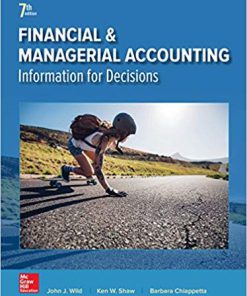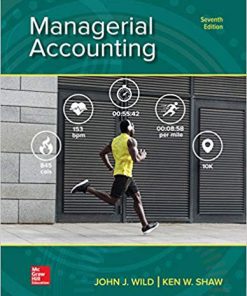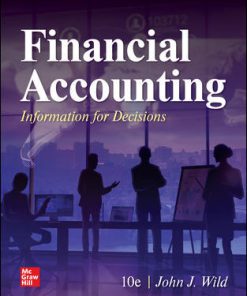(eBook PDF) Financial Accounting for MBAs 7th Edition by Easton; Wild; Halsey
$50.00 Original price was: $50.00.$35.00Current price is: $35.00.
(eBook PDF) Financial Accounting for MBAs 7th Edition by Easton; Wild; Halsey – Instant Download
(eBook PDF) Financial Accounting for MBAs 7th Edition by Easton; Wild; Halsey – Digital Ebook – Instant Delivery Download

Product details:
- ISBN-10 : 1118379721
- ISBN-13 : 978-1118379721
- Author: P. D. Kimmel, D. E. Kieso J. J. Weygandt
Students get accounting when using Kimmel Financial Accounting with WileyPLUS because we make learning accounting easy and accessible for today’s different types of learners. Written in a concise, clear, and conversation way, Kimmel Financial Accounting provides just the right amount of information students need to come to class prepared, while powerful visuals and Interactive Tutorials make complex accounting concepts possible to absorb quickly. Starting with the big picture of financial statements first, Paul Kimmel shows students why financial accounting is important to their everyday lives, business majors, and future careers. This best-selling financial accounting text is known for the most relevant and easy to understand examples, while teaching students the accounting cycle through the lens of one consistent story of Sierra Corp, an outdoor adventure company. The automatically graded WileyPLUS problem-solving experience imitates a blank sheet of paper with type-ahead for entering account titles, so that students use recall memory when they practice or do homework online. More students get accounting when using Kimmel Financial Accounting with WileyPLUS, because they can Read It, See It, Do It – Get It.
Table contents:
1 Accounting in Action 1-1
Knowing the Numbers 1-1
1.1 Accounting Activities and Users 1-3
Who Uses Accounting Data 1-4
Data Analytics 1-5
1.2 The Building Blocks of Accounting 1-7
Ethics in Financial Reporting 1-7
Accounting Standards 1-8
Measurement Principles 1-9
Assumptions 1-9
1.3 The Accounting Equation 1-12
Assets 1-12
Liabilities 1-13
Equity 1-13
1.4 Analyzing Business Transactions 1-14
Accounting Transactions 1-15
Transaction Analysis 1-16
Summary of Transactions 1-21
1.5 Financial Statements 1-22
Income Statement 1-24
Retained Earnings Statement 1-24
Statement of Financial Position 1-24
Statement of Cash Flows 1-25
Comprehensive Income Statement 1-25
Appendix 1A: Career Opportunities in Accounting 1-27
Public Accounting 1-27
Private Accounting 1-28
Governmental Accounting 1-28
Forensic Accounting 1-28
A Look at U.S. GAAP 1-48
2 The Recording Process 2-1
Accidents Happen: Bank of Taiwan 2-1
2.1 Accounts, Debits, and Credits 2-2
The Account 2-2
Debits and Credits 2-3
Equity Relationships 2-7
Summary of Debit/Credit Rules 2-7
2.2 The Journal 2-8
The Recording Process 2-8
The Journal 2-9
2.3 The Ledger and Posting 2-11
The Ledger 2-11
Posting 2-13
Chart of Accounts 2-14
The Recording Process Illustrated 2-14
Summary Illustration of Journalizing and Posting 2-20
2.4 The Trial Balance 2-22
Limitations of a Trial Balance 2-23
Locating Errors 2-23
Currency Signs and Underlining 2-23
A Look at U.S. GAAP 2-47
3 Adjusting the Accounts 3-1
What Was Your Profit? 3-1
3.1 Accrual-Basis Accounting and Adjusting Entries 3-2
Fiscal and Calendar Years 3-3
Accrual- versus Cash-Basis Accounting 3-3
Recognizing Revenues and Expenses 3-3
The Need for Adjusting Entries 3-6
Types of Adjusting Entries 3-6
3.2 Adjusting Entries for Deferrals 3-7
Prepaid Expenses 3-7
Unearned Revenues 3-11
3.3 Adjusting Entries for Accruals 3-14
Accrued Revenues 3-14
Accrued Expenses 3-16
Summary of Basic Relationships 3-19
3.4 Adjusted Trial Balance and Financial Statements 3-22
Preparing the Adjusted Trial Balance 3-23
Preparing Financial Statements 3-23
Appendix 3A: Alternative Treatment of Deferrals 3-26
Prepaid Expenses 3-27
Unearned Revenues 3-28
Summary of Additional Adjustment Relationships 3-29
Appendix 3B: Financial Reporting Concepts 3-30
Qualities of Useful Information 3-30
Assumptions in Financial Reporting 3-31
Principles in Financial Reporting 3-31
Cost Constraint 3-32
A Look at U.S. GAAP 3-58
4 Completing the Accounting Cycle 4-1
Speaking the Same Language: IASB 4-1
4.1 The Worksheet 4-3
Steps in Preparing a Worksheet 4-3
Preparing Financial Statements from a Worksheet 4-11
Preparing Adjusting Entries from a Worksheet 4-12
4.2 Closing the Books 4-13
Preparing Closing Entries 4-13
Posting Closing Entries 4-15
Preparing a Post-Closing Trial Balance 4-17
4.3 The Accounting Cycle and Correcting Entries 4-20
Summary of the Accounting Cycle 4-20
Reversing Entries—An Optional Step 4-20
Correcting Entries—An Avoidable Step 4-20
4.4 Classified Statement of Financial Position 4-24
Intangible Assets 4-25
Property, Plant, and Equipment 4-26
Long-Term Investments 4-26
Current Assets 4-26
Equity 4-27
Non-Current Liabilities 4-27
Current Liabilities 4-28
Appendix 4A: Reversing Entries 4-30
Reversing Entries Example 4-30
A Look at U.S. GAAP 4-59
5 Accounting for Merchandise Operations 5-1
Who Doesn’t Shop?: Carrefour 5-1
5.1 Merchandising Operations and Inventory Systems 5-3
Operating Cycles 5-3
Flow of Costs 5-4
5.2 Recording Purchases Under a Perpetual System 5-7
Freight Costs 5-8
Purchase Returns and Allowances 5-9
Purchase Discounts 5-10
Summary of Purchasing Transactions 5-11
5.3 Recording Sales Under a Perpetual System 5-11
Sales Returns and Allowances 5-13
Sales Discounts 5-14
Data Analytics and Credit Sales 5-15
5.4 The Accounting Cycle for a Merchandising Company 5-16
Adjusting Entries 5-16
Closing Entries 5-17
Summary of Merchandising Entries 5-17
5.5 Financial Statements for a Merchandiser 5-19
Income Statement 5-19
Classified Statement of Financial Position 5-23
Appendix 5A: Worksheet for a Merchandising Company 5-25
Using a Worksheet 5-25
Appendix 5B: Periodic Inventory System 5-26
Determining Cost of Goods Sold Under a Periodic System 5-27
Recording Merchandise Transactions 5-28
Recording Purchases of Merchandise 5-28
Recording Sales of Merchandise 5-29
Journalizing and Posting Closing Entries 5-29
Using a Worksheet 5-31
Appendix 5C: Adjusting Entries for Credit Sales with Returns and Allowances 5-33
Data Analytics in Action 5-54
A Look at U.S. GAAP 5-58
6 Inventories 6-1
“Where Is That Spare Bulldozer Blade?”:
Komatsu 6-1
6.1 Classifying and Determining Inventory 6-2
Classifying Inventory 6-2
Determining Inventory Quantities 6-4
6.2 Inventory Methods and Financial Effects 6-7
Specific Identification 6-7
Cost Flow Assumptions 6-8
Financial Statement and Tax Effects of Cost Flow Methods 6-11
Using Inventory Cost Flow Methods Consistently 6-13
6.3 Effects of Inventory Errors 6-14
Income Statement Effects 6-14
Statement of Financial Position Effects 6-15
6.4 Inventory Statement Presentation and Analysis 6-16
Presentation 6-16
Lower of Cost or Net Realizable Value 6-16
Financial Analysis and Data Analytics 6-17
Appendix 6A: Inventory Cost Flow Methods in Perpetual Inventory Systems 6-21
First-In, First-Out (FIFO) 6-21
Average-Cost 6-22
Appendix 6B: Estimating Inventories 6-23
Gross Profit Method 6-23
Retail Inventory Method 6-24
Appendix 6C: LIFO Inventory Method 6-25
Data Analytics in Action 6-47
A Look at U.S. GAAP 6-50
financial accounting ifrs
financial accounting seventh edition
financial accounting theory 7th edition
financial accounting for mbas 7th edition
|
international financial management 7th edition
|
You may also like…
Business & Economics - Accounting
Financial and Managerial Accounting 9th Edition John Wild – eBook PDF











